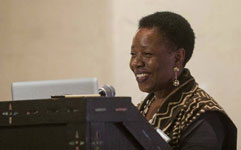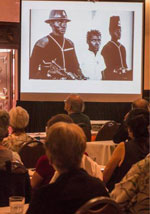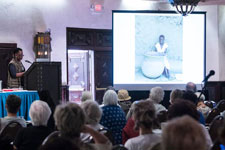
L E C T U R E S . A N D . P R E S E N T A T I O N S

CULTURAL INHERITANCE, NURTURE OR EDUCATION: WHAT SHAPES THE WORK WE MAKE?
Magdalene Odundo
Over the last few years I have returned home to Kenya regularly to visit and it has been rewarding for me to have been given the opportunity to participate in various cultural events, conferences, forums and festivals. During intervals and breaks away from cultural activities there been time to have informal discussions and debates on art national and international. At home (Kenya) I am now considered “veteran” and as such a candidate for interviews and press coverage. Inevitably among the many questions that vary from how old am I, the most asked are on defining Cultural Heritage, Material Culture, Identity, African Art vs Global Art, influences etc. For the youth aspiring to make art, what opportunities, education and reality of survival in the art world. When these questions are focused on one, they are often very difficult to answer without providing some kind of an autobiographical account of oneself. The question on whether one’s cultural heritage, identity and background influence or have an impact on artistic work and life seem important and relevant to. I have always been reticent and uninterested to link background to what I have always considered as a “metier” of personal choice. However, perhaps these questions are not that that insignificant and relevant here at the AIAC conference as well. I have often asserted that nurture and education is more of a determining factor than the former. If my own assertions are correct, then the history of my passage to here is worth associating with the history of the passage of my work.
Kenya in the late 1950’s and 1960’s was emerging from the liberation civil war against the British, the “Mau Mau” uprising. Kenya gained its independence in December 1963. My father had had a brief working assignment in India in the mid 1950s. Here he would have met with dignitaries like Prime Minister Nehru and perhaps even the young Indra Ghandi. For my siblings and myself the positioning would therefore have meant two lived contrasting cultures Indian and Kenyan. Meanwhile in Kenya there was a colour-bar and the two groups would not have interacted. My brother and I went to Catholic schools in New Delhi and here we experienced an integrated environment. When we returned to Kenya in 1957 we spoke English, Kiswahili and Hindi in that order. Before going to India, I lived with my aunt, my mother’s sister at the coast of Kenya and was truly immersed in the coastal culture which continues to informs much of who I am today. The coastal culture thus having much more influence on me than the hinterland of my ancestral heritage. Identity defining conflicts?
My assertion that nurture, education and environment may have a bigger impact on my work and on I have become to be. This is because the early politics of Kenya, my parents involvement with Kenyan politics, the people who played part in my education and my nurture at the coast of Kenya seem to have played a bigger role in influencing my thinking. (image 2 the capture of Dedan Kimathi)
The privation of cultural education during colonial Kenya was total. The missionaries made many attempts to deal with their perception of nudity by introducing adaptations of various costume styles. Here an example from Madagascar a style also adapted in Uganda as a “Busuti” There was not attempt to style a comfortable attire to suit the native lives. (image 3)
In 2000 whilst working on a Crafts Council project, the exhibition “Acknowledged Sources: An Installation” I became aware that there was milage in looking at this history with more detachment without giving up some subjectivity. The project “Acknowledged Sources” was very apt as it became for me a self curated autobiographical installation that provided me with a platform to play and display a small personal history. The Russell-Cotes Art Gallery and Museum, Bournemouth was founded on a very Victorian private collection by the owners the Russell-Cotes’ The collection had its very own subjective British and very Victorian one, with echoes of imperialism and colonial triumphalism. (images 4-10)
At a recent presentation I gave examples from an African perspective to support the notion that nurture and education played a greater role in the work genre an artist was making (images 11-27).
 I think that my my art work has been very much influenced and defined by my history of passage, events, circumstances, education and environment. Education certainly a major part of this formation. Had I not gone to the schools I went to, had I not travelled, had I not decided to stay in the Uk and so on, it is impossible to imagine what kind of work I would be engaged with. Access to material culture has helped to nurture the art. Good art history teachers mattered and opened visual curiosity to artists like Giacometti (images 28-30) I think that my my art work has been very much influenced and defined by my history of passage, events, circumstances, education and environment. Education certainly a major part of this formation. Had I not gone to the schools I went to, had I not travelled, had I not decided to stay in the Uk and so on, it is impossible to imagine what kind of work I would be engaged with. Access to material culture has helped to nurture the art. Good art history teachers mattered and opened visual curiosity to artists like Giacometti (images 28-30)
My ceramics teacher Henry Hammond instilled in me the love for observational drawing and |Walter Keeler made one realise that the wheel was a tool to be exploited and throwing could be fun (images 31-32) and although I was disappointed to have just missed being taught by Hans Coper at the RCA (33-34) I was lucky enough to have been taken to visit Lucy Rie on several occasions by Prof. David Queensberry.
It is however, Kerma ceramics (images 36-37) from the second cataract along the River Nile in Sudan that are for me owe inspiring. This work is often attributed to Egypt but much of the archeological find has been in the Sudan. I first saw these pots at University of London Petrie Museum and they have never ceased to amaze and continue to inspire me. They have a universality that is so contemporary and need not explanation. They could be made in any clay but these particular one are very comfortable in terracotta.
When I began to work with glass recently this long passion for Kerma pots led to a rediscovery of my interest in the body and body adornment. These early Egyptian 5000 BC ear studs were the trigger for the glass installation for the exhibition “Tweak: Converts to Glass” at Museum of Glass, Tacoma, during NCECA (images 38-48) and a current installation at the National Centre for Glass at Stourbridge, Sunderland in England (49-51).
In the end however, I would like to think of my work as having an identity of its own formed or fashioned by me. I believe that in the work I make, nuances of my experience are evident and that the references appropriated reflected in the work are my adaptation of the appropriated. That the stances and gestures that sing my song, celebrate the history of making made by myself and others in our world of art. I extemporise where possible and return to the notation of the original to acknowledge the sources and the rich material culture that is global. I stand on the tips of my toes to mimmic Giacometti for stance, to acknowledge Henry Hammond my teacher for enthusing on the virtue of drawing, Gwen Hansen-Piggot and Hans Coper for giving me the licence to be repetitive in the quest for simplicity. And the search goes on with steps backward into history and forward into the unknown especially the digital world. The historical (52-54) being very important and mine an interface of what will come tomorrow! (55-112)
In the end the identity and cultural imperative questions cannot be answered in a way that fits all. In my studio the questions make a good conversation more with myself than with anybody else out there. When asked questions of identity, culture and self expression, I might contrive to answer with justifiably lengthy verbose polemic. Identity for mine is intertwined with the universal (global) history of making objects and thus a search for a ”Global” identity. I cannot improve on these classical works (124-130). But I can expressed myself through acknowledging the historical and contemporary sources through my own art and by imbuing my own spirit and gesture into each piece, arresting a stance, a gesture and poise to the work and instilling in each a spirit to please and appease soul and body!
Thank you
Magdalene Odundo is Professor of Ceramics at the University for the Creative Arts, Farnham, England. In 2008 sShe was appointed Officer of the Order of the British Empire (OBE). |